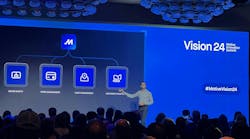Battle lines are being drawn in the long-awaited fight over ergonomics regulations now that OSHA has released a proposal that could affect about 27-million workers at 1.9-million work sites, including those in trucking.
OSHA claims that 300,000 workers could be spared disabling injuries annually, and that savings for worker's compensation and other associated costs could reach $9 billion.
Costs questioned The trucking industry and some other business groups beg to differ. While OSHA pegs the cost of compliance at $4.2 billion for all U.S. companies, officials at the American Trucking Assns. (ATA) say the cost will be $6.5 billion for trucking alone. Basing their figures on a 1995 draft of the proposal, ATA officials believe OSHA's estimate of the number of employees covered is woefully low, as is the cost of mandated employee downtime after an injury. "OSHA's numbers are grossly off base," says Stuart Flatow, ATA's direct of occupational safety and health. A recent study by the Small Business Administration found that OSHA's estimate may be 2.5 to 15 times too low and the benefits may be overstated.
The proposal targets musculoskeletal disorders (MSDs) that occur when workers and jobs are mismatched. For example, an MSD could occur when a worker lifts a load that is too heavy. MSDs cover injuries to muscles, tendons, ligaments, joint cartilage, and spinal disks. To be considered a true MSD, the injury must be diagnosed by a health-care professional and be serious enough to require medical treatment, as well as days off for recovery. It also must be directly related to the person's job and not caused by a peripheral activity.
For the most part, trucking jobs covered under this proposal would be those connected to moving freight across a dock or in a warehouse, and delivering packages. It's not clear whether drivers could claim muscular or nerve injury from repeated vibrations sustained while driving. However, the proposal does mention issues such as "driving for several hours without a break."
Employers usually will fall under one of two programs: Basic or Full. The Basic Program requires that employers name someone responsible for ergonomics to supply training. It also requires that they provide employees with periodic information on risk factors, such as how to lift items, work in extreme temperatures, and recognize signs and symptoms of MSDs, as well as the importance of reporting symptoms early.
For employers whose workers have already sustained an MSD, the Full Program is necessary. They must analyze problem jobs for ergonomic risk factors; work with employees to eliminate or reduce MSD hazards, using engineering, administrative, or work-practices controls; use protective equipment; and track progress. Employers also must put training programs in place.
The proposal also offers a Quick Fix feature. If employers address an ergonomic problem within 90 days and check that the fix works, no further action is required.
One of the most controversial sections is time off after an injury. The proposal calls for workers to get time off for recuperation while receiving 90-100% of benefits. Workers transferred to reduced or light duty would receive full pay and benefits.
Companies that have already developed ergonomics programs don't need to do it again, provided their programs meet the obligations of the new standard, were implemented before the new standard becomes effective, and "eliminate or materially reduce" MSD hazards.
The proposal exempts construction, maritime, and agriculture sectors, mainly because of the difficulty in controlling and monitoring work environments. This provision has the trucking industry particularly upset because drivers on the road are away from the worksite, too.
Industry groups opposing the proposal take the stand that OSHA should not put any ergonomics regulation on the books until the National Academy of Sciences report on ergonomics is published, which could take a few more months. They claim that this will provide definitive scientific data about ergonomic injuries - something they claim the OSHA proposal lacks.
Comments on OSHA's proposal are due February 1, and informal public hearings are set for February 22. If the proposal stands, it could become effective by year end.
Establishes separate safety agency for motor carriers
President Clinton signed the Motor Improvement Act of 1999 last month, which establishes a separate DOT agency called the Motor Carrier Safety Administration.
In passing the law, Congress noted that the "current rate, number, and severity of crashes involving motor carriers in the U. S. are unacceptable," and that the "Dept. of Transportation is failing to meet ... deadlines for completing some significant safety rulemaking proceedings."
Highlights of the law, which was to go into effect Jan. 1, 2000, include:
* The Administration's focus will be on safety and crash prevention;
* An Administrator appointed by the President;
* A 70% increase in funding - about $38 million annually for research, rulemaking, and enforcement;
* An owner or operator of a commercial vehicle who doesn't pay a penalty within 90 days is barred from interstate commerce;
* A carrier that operates without proper authority can be placed out of service;
* A driver that causes a fatal crash will have his license suspended;
* One-year suspension for drivers operating without a valid CDL. There is permanent revocation for a second offense;
* An increase in the number of inspectors at the Mexican border;
* Mexican fleets illegally operating in the U.S. could face fines up to $10,000 and be banned from operation for up to six months;
* Follow-up visits for are required for carriers with "less-than-satisfactory" ratings
The 1999-2000 edition of the TTS Blue Book of Trucking Companies is available from Transportation Technical Services.
The Blue Book contains individual data from 1,525 motor carriers, including income statements, balance sheets, and operating expenses. "Summary data provide an excellent means for individual carriers - whether for-hire or private - to benchmark their operations against the best performers in their industry or market segment," says Ron Roth, executive-vp of TTS.
Revenues were up 9.7%, running slightly ahead of expenses, which were up 9.4%. Operating ratios improved (95.08 to 94.82) and return on equity surged to nearly 16%.
Copies ($245) are available from TTS. Call 1-888-665-9887, or visit the Web site: www.ttstrucks.com.
A bill has been introduced to provide an income tax credit of $250 for each "qualified" commercial PTO a taxpayer owns. Currently, qualifying is defined as trash trucks and concrete mixers, but other types could be added if the bill moves ahead. The bill's chances are iffy for 2000, however, because it's uncertain any tax legislation will pass and because the IRS and Congress's own nonpartisan Joint Committee on Taxation staff have always opposed relief for PTOs.
Rollins Leasing Corp. has acquired Keen Leasing, Harrisburg, Pa., giving the company 13 additional branches in Pennsylvania, Maryland, and Virginia, and adding 2,000 vehicles to its fleet.
The Office of Motor Carrier Safety is offering a free CD-ROM training program in English and Spanish that covers the legal requirements for CDL drivers and others involved in carrying hazardous materials. For information, contact the agency's Southern Resource Center at 404-562-3704 or the Western Resource Center at 415-744-2665.
TIP Intermodal Services purchased 11,473 intermodal trailers from Redon, Jacksonville, Fla., bringing the fleet to 26,000 units.
Consolidated Freightways has expanded its European service through an alliance with Merzario S.p.A., an international freight forwarder headquartered in Milan, Italy.
USF Glen Moore, the truckload subsidiary of USFreightways Corp., has acquired Underwood Trucking, a Brazil, Ind.-based TL carrier.
Fleets with as few as 50 vehicles can now file New York City's Commercial Motor Vehicle Tax (CMVT) electronically. Companies receive a record layout detailing the format for electronic filing. Data is matched against the department's CMVT database to determine the amount of tax owed for each vehicle.
* Gary Masse has been named president of Jacobs Vehicle Systems.
* David Bruce has joined Ryder Systems Inc. as director-public relations; Scott Mall has been appointed to the position of vp-corporate communications.
* William D. Zollars has been named chairman, president and CEO of Yellow Corp.
* W. Patrick Warmington becomes president of Ravens Inc.
* Hendrickson Truck Suspension Systems has appointed Doug Sanford director, OEM Marketing Group. Doug Henson assumes responsibility for the Aftermarket and Elastomers Group; and John Ruley becomes product manager for non-drive systems. In addition, Hendrickson has named Keith Gelinas sales director-truck products; Dave Overmyer director-sales for fleets and vehicles; Beverly Pierce director-corporate communications; and Roxanne Szczypkowski manager, marketing communications.
* Haldex Brake Systems Div. has promoted Duane Stocksdale to director of OEM marketing.
* Robert E. Ostendorf Jr. has been named president of Morgan Corp. Shaun Luther becomes vp and general manager-Parts and Service Div.
* Intrenet Inc. has hired John P. Chandler as chief operating officer.
* GE Capital Fleet Services has appointed Marian Powell senior vp of e-commerce.
* D-A Lubricant Co. has promoted Fred Roedl to director-sales and marketing for North America.
* Patrick Wise has been named vp-electronic commerce for Landstar System Inc.
* Bruce Channer becomes vp-sales and marketing for Red Dot Corp.
* Bob Ashcraft has joined PACCAR Leasing as national accounts sales manager. Lynn Carson becomes central region manager.
* David E. Breedlove has been elected chairman of the Truck Manufacturers Assn. (TMA) board of directors for 2000.


